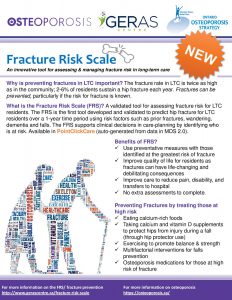Fractures are a serious health concern for older adults living in long-term care (LTC) and cost $1.03 billion annually in Canada. Research shows 45% of LTC residents are at high risk for fractures.
Fractures occur more frequently among LTC residents than community-dwelling older adults and include the hip, spine, wrist, shoulder and long bones. Fractures often occur with a fall due to bone fragility and contribute to poor health, reduced quality of life, reduced mobility, loss of independence and mortality.
The FRS is the first tool of its kind developed and validated to predict hip fracture for LTC residents over a 1-year time period, using risk factors such as prior fractures, wandering, dementia and falls. This tool integrates both fall and fracture risk factors and can be used as an aid to support clinical decisions in care-planning and should be included as part of a comprehensive clinical evaluation where the preference of the resident needs to be considered.
Why is the FRS important?
- The FRS is the first tool of its kind developed specifically for the LTC population. It makes assessment for fractures easy.
- Improved quality of life for residents – fractures can have life changing and debilitating consequences.
- By identifying residents at high risk for fractures, the FRS ensures improved care to reduce pain, disability, reduced quality of life and transfers to hospitals.
 The FRS tool is user-friendly and does not require health care professionals to complete additional assessments. Embedded in MDS 2.0 by Point Click Care or the LTCF, the FRS tool automatically calculates the risk of a hip fracture for every LTC resident based on their MDS 2.0 assessment data. Ask your software vendor about your LTC home’s FRS implementation status. Check out the: FRS Information Sheet.
The FRS tool is user-friendly and does not require health care professionals to complete additional assessments. Embedded in MDS 2.0 by Point Click Care or the LTCF, the FRS tool automatically calculates the risk of a hip fracture for every LTC resident based on their MDS 2.0 assessment data. Ask your software vendor about your LTC home’s FRS implementation status. Check out the: FRS Information Sheet.
The FRS has been developed by the Ontario Osteoporosis Strategy for Long Term Care (OOS LTC) and in partnership with Osteoporosis Canada, the Ontario Osteoporosis Strategy, GERAS Centre for Aging Research, Hamilton Health Sciences, University of Waterloo and McMaster University.
The mandate of the OOS LTC Strategy is to reduce morbidity, mortality and costs from osteoporotic fractures using a resident-centred, multi-disciplinary, care team approach. The OOS LTC Strategy aims to increase awareness of fractures risk among residents and to provide healthcare professionals with information, resources and tools to effectively implement recommended care interventions from fracture prevention guidelines.